Politics of a new media space inside the Lietuva (soviet) cinema
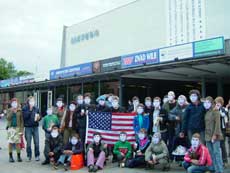
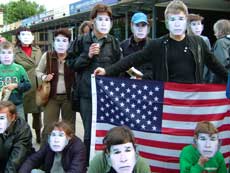
Interview with Nomeda & Gediminas Urbonas
By Geert Lovink
Ever since I met Nomeda and Gediminas Urbonas in 1999, two contemporary artists from Lithuania, they have been in search for an art space where they could establish a media lab, host talks and exhibit new media related art works. In August 2004 their organization, Vilma, hosted the RAM 6 workshop in Vilnius–yet another example which showed how well organized they were, and how desperate in need they were for their own infrastructure to do critical and innovative projects. This spring, Nomeda and Gediminas suddenly saw a chance–and grabbed it. They occupied the huge voyer of the privatized Lietuva cinema, over which a controversy had arisen. In May 2005 Nomeda and Gediminas were in Amsterdam briefly for the opening of the Populism show at the Stedelijk Museum, a moment we used to catch up and prepare for the following interview, which was done through email over the past few weeks. The situation of their exciting project is changing on a daily basis and we’ll hope to keep you informed. In the meanwhile, if you would like to support them, for instance by sending them taping which they could screen, please contact them. Email plus URLs can be found below.
GL: Hi, how are you? It’s been an exciting few months for you. Tell us all about the space. How does it look inside? And what’s happening inside, for instance last week?
NU & GU: To tell all about the space, we should make a short story long and introduce you to the context. Since independence in 1991 Lithuania has been caught in an insane period of privatization, property development and demolition. Like a Wild West land-grab or a gold rush, speculators and real estate tycoons have joined forces with corrupt municipal bureaucrats to redevelop the country at a mad pace. Profit has been their only motive. Public space, landmark buildings, cultural life, and public opinion have been the principal victims. Their method is simple: tell the population that economic development is good for everyone. Convince them that Capital is King. Remind the public that making Lithuania look like the pale shade of a Western European city is the best way to scrub the Soviet past: and make the country attractive to even more investment and development.
During Soviet times, cinema played an important role in public cultural life. Large movie theatres were built in central locations around Lithuanian cities. The theatres filled a crucial role as places for public meetings and gatherings. After independence, as Soviet structures rapidly crumbled in a wholesale fashion, the cinemas caught the attention of the real estate market. In a short time, private enterprise managed to take over and destroy almost every cinema in Vilnius, turning them into apartments and supermarkets.
More than 15 cinema theatres disappeared including such urban landmarks as Ausra (Dawn), Zvaigzde (Star), Spalis (October), Pionierius (Pioneer), Pergale (Victory), Tevyne (Motherland), Kronika (Newsreel), Aidas (Echo), Planeta (Planet), Neris, Vingis, Lazdynai, Vilnius, Maskva (Moscow), and LIETUVA (Lithuania). In poor replacement, and mirroring the tragedy of cities all over the world, two 2 multiplex cinema monsters were constructed: the suburban Coca Cola Plaza and exurban Akropolis Cinemas. The latter, that is part of Lithuania’s largest shopping mall, is representative of the ‘mallification’ of Lithuania. With the multiplexes came multiplex Hollywood movies: so the demolition of cinematic space encoded a demolition of independent film programming.
Now, in 2005, there is only one cinema standing: LIETUVA. And a battle has emerged to save it. Cinema Lietuva was built in 1965 and, significantly, is the largest cinema in Lithuania with over 1000 seats and a screen size of 200 square meters, offering an ideal image size. It is the home of the Vilnius Film Festival and as such has played an important role in the imaginative life of a whole generation of Vilnius people. The title of the enterprise “Lietuva” (Lithuania) is also an important signifier of national identity, as its name never bore any Soviet overtones (i.e. it wasn’t called the Cinema of the Soviet Republic of Lithuania). To say to somebody “let’s meet at Lietuva” really meant something during Soviet occupation.
In 2002, the Vilnius Municipal authorities quietly sold the cinema to private property developers; with a caveat that it had to operate as a cinema for a three-year period. That term is ending on 1 July 2005 and a protest to save the cinema has begun.
In March 2005 we infiltrated the former ticket office of the country largest cinema, staging the ‘pro-test lab’, which is the embodiment of VILMA – Vilnius Interdisciplinary Lab for Media Arts. Pro-test lab is constructed as a spatial device to register the scenario of protest and generate an action. The logic of the spatial device refers to the Brothers Lumiere early model of the cinema camera that performed a twofold function both recording and projecting the action. Pro-test lab is generating and archiving all available forms of protest against the situation of the Cinema Lietuva focusing on the discourse of public space vs. corporate privatization. The protest is aimed at reclaiming the now privatized space.
Pro-test lab is testing the understanding of possible and/or impossible forms of protest. It is inviting participation in, and facilitating, protest from groups which as yet are unidentified and are searching for ways of making their opinions heard: and the particular activity that would best support their protest. Pro-test lab is actively advertising itself as a space in which anti-establishment, or at least anti-hegemonic, opinion can flourish. The officers of the pro-test lab, and the technical support structure, will help give form to these opinions. Pro-test lab will help develop a protest scenario. It is a production house of protest.
The space of the former ticket office is build as separate segment of larger architectural set rendered in grayish stucco. We have got access to such relatively big space (250 square meters), thanks to the fashion of queuing, largely rehearsed in former times. Even after the 1997 renovation the space preserved the charm of a modernist glass pavilion that encloses the ground floor of the whole building, facing to the larger square of one of a main streets in a city. Two glass walls construct the showcase that faces the street unfolding the space to the passers-by and introducing the character that rather resemble the lounge than a white cube or a black box. The white sealing of a space is sliced with strict stripes of neon lights. Three white concrete columns supporting the sealing stand for the right of notation boards collecting on their surface signatures of support and immediate reactions of a visitors.
Following the genesis of VILMA, as referring to the former soviet factory of recording devices the architecture of the space is has reappearing construction element of a box, that is used for packaging and transportation of recording devices. The space of the Pro-test lab maps and enfolds several architectural and programming aspects, that are suggested as a number of overlapping zones.
The pro-test lab is fitted with LIETUVA TV, a public access television studio called similar to the national television. LIETUVA TV is a meta-zone that maps new visibilities, and documents and archives the protest. LIETUVA TV develops its own format of a so called Talk Show which creates the media space merging geography of the city and cinematic references that challenge contemporary politics in real time debates, moderated by Rytis Juodeika, a film critic and theorist.
‘Modeling Zone’ is a space for thinking and workshops that architecture student club is staging to invite participants interested to model situations: to produce and project visions of [the] future city. The Modeling Zone is for the construction/development of new housing models and for privatization role-playing games to be played. ASK (the Architecture Students’ Club) has developed a daily street game merging Monopoly board-game strategies with local municipality characteristics in a game show “VIP Turgus” that refers to VP market mall chain-–the owner of the cinema.
The ‘Zone of Wishes’ is a lounge space for discussions, chatting and brainstorming in which visitors can exercise their desires. It is a meeting place for a number of citizens’ movements (for their weekly or daily meetings) and a drop-in spot for anyone concerned with the general community lack of awareness about “what’s going on”. Zone of Wishes generates and rehearses the weekly public actions or political petitions.
AViZa (oat) is an alternative kitchen space improvised by young people gathered on a mailing-list to cook the discussions and discuss the secrets of cooking. AViZa invites cultural institutes and agencies to present national cuisines and share their views on city development.
The Polyphonic protest program has been developed by Co:LAB UK, an intern student collective from Dartington College (UK) that suggested to do a bar space as the socializing element every Thursday, offering tea, soup and more. As the sign says: ”cast your ballot (a sum not less than 2 litas) in the box and in return you will get beer, wine or water”. The special sound and visual program is developed for each event. Inside the space of the lab in front of the entrance there is an architectural appendix – an additional space of something like 20 square meters separated by a glass wall, that forms a perfect green house. It is filled with plants and lightened with vegetation lights making the area into a playground to rehearse the deejay in the role of the gardener. This is a zone of a radio station in development.
The Reading Room zone is a space which archives and navigates the protest scenario. It contains a footnote library of disobedience and rebellion, collected according the suggestion or donation based on a good will and collaborative spirit of citizens. It gathers all kinds of documents mapping the development of resistance to privatization and gentrification, including some audiovisual documents, web links, collection of news, papers, magazines and books. Reading Room prepares for a screening program of political forms that uses format of films.
To bring all the activities together we use an Internet forum. To date, this list has been joined by over 150 people, including architecture students, green party activists, vegans, anarchists, musicians, students from TV and cinema school, animators, film world people, theater students, social democrat party, community leaders, casual passers by and regular hangout goers.
The four larger scale TV monitors installed in the lab space broadcast daily the production of Lietuvos TV. Two larger screens are for the event projections. Collaboration with local open source community facilitates the lab with streaming accessed from http://www.vilma.cc/LIETUVA
Now back to your question. What happened, for instance, last week? We had an action “America will help us”, which staggered protest lab fans with contradictory facets. Referring to the hope of Lithuanians that there is a upper will out there, that can rescuer, this myth was reinforced by American Voice radio propaganda during the post war resistance keeping Lithuanian for the next 20 years in forest to beat the resistance record. On the facade of the cinema the huge banner with black and white layout featuring the words of the President of the United States George W. Bush, that from now on, any enemy of LIETUVA is an enemy of the United States, he stated during a visit to Vilnius on November 23 2002. So the initiators of the action masterly planted the cinema in a place of a country calling everyone who is for LIETUVA, join the action seducing with a popcorn, cola and much more. Together with the United States, let’s save LIETUVA from the enemy! People gathered were supplied with masks of the US president to see the world through the eyes of George Bush. Dean Reed, the red Elvis supported the background of the action with his songs performed by a laptop. For local context of radical thought which hardly accepts leftist discourse due a connotation to Stalinist repressions such turn of a pro-test lab activity was mind blowing.
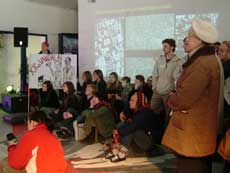
GL: What are your feelings about Soviet modernism? Did you find the building ugly when you grew up? And now? It is true that the current elite would like to knock down the building and replace it with yet another multiplex?
N&G: When we grew up we thought it was great! Absolutely great architecture that brought the urban spirit into the city. It developed the idea of public space, shattering the patriarchal values of soviet state and rural Lithuanian life. It looked western, more Scandinavian maybe, as the scale of such developments in Lithuania was different from Palast der Republik in Berlin. Indeed it was contradicting the baroque architecture and always stood up for something, that encroaches on the very fundamental values. It carried a strong claim for change and the same time for disintegration of the old. When we were kids the cinema was big, new and nice, it had a touch of progressive architecture that brought feelings of openness, of the so-called warming up epoch. Nowadays, despite the grayish and worn out exterior surfaces it remains a strong landmark. It is a document that testifies the desire for public space. From our point it is the best cinema theater in the country.
Politicians only think about making profits. They look at the culture as at the milking cow, and the same way they treat public space. New liberals with real estate tycoons meet the expectation of both former communists and former nationalists to erase traces of the soviet past as they did it with the soviet monuments. In a place of a cinema they plan to build huge penthouse with a shopping center on a ground floor. They were not even thinking about building multiplex, as at the moment is not as profitable as speculation with a real estate.
GL: Your search for a contemporary arts building with media lab facilities has been going for a long time. I remember when we met for the first time, in Kiasma during Temp Lab, late 1999, you were negotiating with a rich person about some gallery space near the central square of Vilnius. Speculation with real estate must be pretty intense. On the other hand, one would think that there are a lot of abandoned buildings, like everywhere in Eastern Europe. Or is this a Western misconception?
N&G: Well Vilnius is not the case. Space is rather controlled. You cannot find any of abandoned space here. Every corner is privatized as there is a lot of Russian money washed here through the real estate business. We are squatting the privatized space now. We call for reclaiming public space and demand for justice, for the right distribution.
During the last years we tried to negotiate with new rich and see if its possible employ their energies into the economy of such new media place. But it was not possible as they would think in the conservative terms, like they would be still only understand the gallery model and would not find enough creative imagination how to challenge it.
GL: What’s the cultural politics like in Lithuania? I heard that the Soros structures were dismantled and that this scene will move into newly establish contemporary arts museum. Still, there is little in terms of infrastructure, in particular in the field of new media.
N&G: Today, all attention goes to the cultural heritage and restoration. Former communist joined their desires with conservatives to rebuild the old royal castle. It seems like the energies of soviet factory builders suspended during last years of privatization as there was no industry development, now get released into the retrospectives. On the other hand they continue to exercise former soviet experience of national spectacle supporting facade culture. Classical music and theater production, even big national song festivals get all the political attention and support. Another problem that understanding of efficiency in culture or public space is reduced to the monetary level.
Indeed, after a few years of lurking in the National Museum the Soros structure came onto the surface in a new embodiment of State Gallery for Modern Art. Seems like the same model is implemented in at least a few of post soviet countries. Its just really sad that in Lithuania in particular the Soros foundation eliminated support for new media initiatives and practices. This is maybe due to their loyalty to national handicrafts and traditional visual culture? Who knows.
There is a visible distrust of the independent organizations or NGO at large in the cultural politics. A large illiteracy about the civil society and civil institutes, like NGO for instance. Only governmental and private enterprises are legitimate. Therefore most of the NGO’s are established by governmental structures just to imitate civil society and through that to pump public money.
The absence of facility in a new media scene probably has certain logic in a lack of awareness of what is this culture and low education level at large. The distribution of public funds is run or headed by old boys network. It is different generation, and not only because of age. On the other hand new media culture is not considered as representative, therefore all resources go for representation.
GL: The Populism show, which opened in Amsterdam early May, has played a central role in process that led to opening of the space inside the cinema. How come? This is an example of ‘global art’ that plays out locally? Do you know of other such examples?
N&G: We are carrying out the idea of a laboratory since a while, probably since a Ground Control project 1997. Since then it went through the different stages being transformed from the artist exchange into television program, then research base for individual projects and international series of workshops. And each time looking and searching for the economies grounded in the local specificity.
We employed the invitation of the Populism show to launch the Pro-test Lab project. And we developed the proposal from the piece limited within the institutional framework into the structure that goes far beyond that, which is the embodiment of media lab that works with local identity and protest agenda. Our interest is how to transgress the art ghetto borders of the encapsulating the work and the practice in the trap of the illustration. It shows that its still possible to play with the “international” card here. Locally we still have strong heritage of a “big brother”, just in this case Moscow is substituted by Brussels. So the international projects are playing role of an external censor that has all legitimate powers to let things happen. Institutional world support because they think its international , its successful and competitive. It has another side as well, as people do not want to be sold, and let their voice to be privatized and exported to the west or the big show. Therefore we had to be very careful not to turn into the same tycoons as we have in art market.
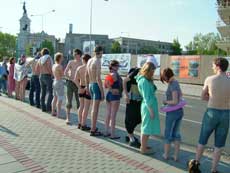
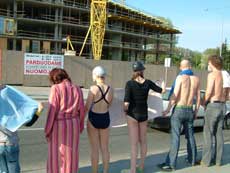
GL: As in many other places, Vilnius suffers from a brain drain of young people and professionals that move to Western Europe, Germany, the UK, the US, to earn a living. Could the cinema space project be read as an attempt to stem this constant flow of ‘dissident’ young people out of the country?
N&G: yes, indeed. We could make the following statement: invest into the Pro-test lab and we won’t bother you with immigration:) It would be a great and yet impossible mission indeed. It would not be fair if the cinema space project would take away the chance people take going to pick up strawberries in Norway or work on construction sites in London. On the other hand, people leave because they are not satisfied with the reduced scenario they are offered through the recent developments in Lithuania. Mallification of the whole country reminds us of the same repressive experience they had during soviet times. Therefore they are looking for countries, cities and situations that cab offer just more interesting cultural life in all respects than that. On the other hand there is a certain social and intellectual upheaval occurring recently and visible activity and presence in the discussions. It means that not only economic factors are effective. Pro-test lab is already acknowledged as contributing to this discourse, encouraging further developments.
So what we try to do instead of being annoyed if London or NY have better offers, we try to have some fun while researching local situations of transformation, reflecting this process and finally encouraging people to construct the future models.
GL: You are soon entering a crucial phase of the project. I suppose you want to keep the space and build a sustainable model for it. How can people outside Lithuania support you? Would you like to organize screenings and even host exhibitions over the next weeks and months?
N&G: We starting from screenings and small scale events like workshops, as education is most important. We would like to collaborate with creative agencies and develop system of hosting and producing international workshops that would sustain the search and development of new media practices. We see VILMA as alternative education and production center. And through that we would also build identity for VILMA and the system of plug-ins including television, radio, library and experimental production including such practices as urban agriculture for instance. Everyone who is interested are welcome to join and propose the support or collaboration.
We try to invest into the local context, translating some of seminal writers’ writings on new media as well as encouraging local thinkers to write on media culture at large. Only some of it comes in English, as we cannot cope with translations. The most crucial would be translation support and editing of English. Then we would be needing someone joining voluntary with critical awareness, that could enjoy working in hard conditions helping to build the self sustained structure. Also we ask for support building media library: films, DVDs, CDRoms, web links and texts.
And at last but not the least we need an international support letter directed to the Parliament, the Prime Minister, the Minister of Culture, and the Mayor of Vilnius to support our activity and preserve the space for independent cinema and new media practice in Vilnius. The only in the country.
—
Email of Pro-test lab: info@vilma.cc.
Relevant URLs:
http://www.vilma.cc/LIETUVA
http://www.vilma.cc
http://www.baltictimes.com/art.php?art_id=12887

